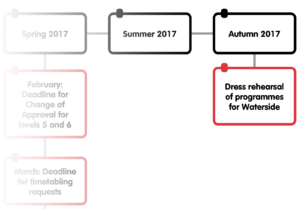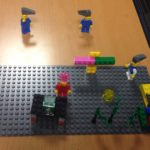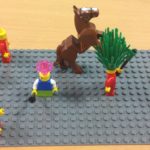The NILE design standards for the 2021/22 academic year were approved at the Student Support Forum meeting on the 15th of April 2021, and have now been published.
The most significant change to NILE design standards for 2021/22 is the inclusion of the design standards for Ultra courses (see, ‘Section B, Tables 5.1, 5.2 and 5.3’).
The design standards for Original courses remain largely unchanged. The only changes of note from the previous year’s standards are:
- Clarification that, should staff wish to, it is fine to update the course landing page from ‘About this module’ to ‘Announcements’ after the first few weeks of teaching (see, ‘Section C, Table 6, About this module [Entry Point*]’.
- Renaming ‘Virtual classroom’ to ‘Blackboard Collaborate’ and having this area available by default (see, ‘Section C, Table 6, Blackboard Collaborate’).
- Removal of the ABL definition from the landing page on programme-level courses (see, ‘Section C, Table 7, My Programme [Entry Point’].
The NILE design standards for 2021/22 are available to view at:
https://libguides.northampton.ac.uk/learntech/staff/nile-design/nile-design-standards
 At the recent Learning and Teaching Conference, the Learning Design team hosted a ‘cracker barrel’ table to help staff think about how to approach course (re)design. Those that came to the session were also given an action planner document, which included key dates in the academic calendar between now and the autumn term 2017, when most programmes will be expected to be running in a format appropriate to Waterside delivery.
At the recent Learning and Teaching Conference, the Learning Design team hosted a ‘cracker barrel’ table to help staff think about how to approach course (re)design. Those that came to the session were also given an action planner document, which included key dates in the academic calendar between now and the autumn term 2017, when most programmes will be expected to be running in a format appropriate to Waterside delivery.
For anyone that missed the session, you can find the planner here: Planning for Waterside timeline (PDF, 275KB)
If you would like any help with your planning, please contact the Learning Designers at LD@northampton.ac.uk.
At recent events, including last week’s Learning and Teaching conference, the Learning Design team have been trying out some new activities to help teaching staff think about how they design for learning. You may have seen some of these new tools and activities described in earlier posts in this category, or had the chance to have a go at using them in development events. In this post I’d like to look at the bigger picture of how these might fit together with some of the other services we offer.
At the conference, we hosted a ‘cracker barrel’ table. The staff that came to see us were offered giant post-its (no small motivation!) in exchange for drawing us a picture of what they value most in their teaching. You can view these in our online album here (we’ll be adding more from other events to this album too):
 |
| What I value most in teaching |
The resulting images were not just works of art. They could also be seen as ‘teaching metaphors’ (McShane 2005). We asked participants to expand on these, and break down what was happening in the image using three key questions:
- what is the role of the tutor?
- what is the role of the student?
- what is the role of technology?
Common themes in the role of the tutor included motivation, guidance, facilitation and enabling, linking learners together and lighting ‘sparks’ and ‘light bulbs’ of understanding. There was also an emphasis on pastoral roles, being ‘approachable’, ’empathetic’ and a ‘confidant’. The role of the student was widely agreed to be participative, with comments noting the importance of engaging, contributing and becoming autonomous. Some comments also noted that the distinction between tutor and student is not so dichotomous, and that learning happens in a community where the participants all learn together. Comments on the role of technology mostly focused on supporting access to learning, as well as ‘fostering community’ and enabling sharing. You can see all the contributions in this PDF file (3.5MB, captured using the Post-It Plus app).
 Sadly that was all we had time for on the day, but we did ask them to go away and think about how their image related to their own programmes and modules. Is that ideal teaching moment what’s happening in those modules now? And if not, what could they change that might enable them to do more of what they value?
Sadly that was all we had time for on the day, but we did ask them to go away and think about how their image related to their own programmes and modules. Is that ideal teaching moment what’s happening in those modules now? And if not, what could they change that might enable them to do more of what they value?
This led me to think about a model that I had been introduced to by our very own Deborah Forbes, in a staff development session on Thriving in a Changing Environment*. The model is Appreciative Inquiry (AI), and as a positive approach to change management it has a lot to offer as we prepare for Waterside. Here’s what some of the experts have to say about AI:
“The traditional approach to change is to look for the problem, do a diagnosis, and find a solution. The primary focus is on what is wrong or broken …Appreciative Inquiry suggests that we look for what works in an organization …Because the statements are grounded in real experience and history, people know how to repeat their success.” (Hammond, 1998, pp.6-7)
And:
“[Appreciative Inquiry] deliberately seeks to discover people’s exceptionality – their unique gifts, strengths, and qualities. It actively searches and recognizes people for their specialties – their essential contributions and achievements. And it is based on principles of equality of voice – everyone is asked to speak about their vision of the true, the good, and the possible.” (Cooperrider, 2001, p.12)
Although there is no one definitive model for AI, the 4-D aproach is widely used. This consists of four main steps:
- Discover: The identification of organisational processes that work well.
- Dream: The envisioning of processes that would work well in the future.
- Design: Planning and prioritising processes that would work well.
- Destiny: The implementation (execution) of the proposed design. (Cooperrider and Whitney, 2005, p.17)
In terms of programme and module design, the steps we covered at the conference were targeted at the ‘discover’ and ‘dream’ stages – by helping staff to think about what works really well for them and their students, they can begin to think about what their programme or module might look like if they did more of it. This begins a process that then feeds in to the beginning of the CAIeRO, where staff are asked to outline their aims for the programme or module, create a mission statement for it, and think about the ‘look and feel’ (see this post for more on this). The CAIeRO process then leads the course team through the ‘design’ stage towards the ‘destiny’ or delivery of the new or re-designed modules.
Do you have positive stories to share about what you love about teaching, what’s working well, and what it should look like in the future? Would you like to contribute to the conversation? Then why not add your comments, send us a picture (along with a brief outline of what’s happening), or write us a case study? You can comment on this post, or email the Learning Design team at LD@northampton.ac.uk.
References:
Cooperrider, D.L. (2001) Why Appreciative Inquiry? In Cooperrider, D.L., Hammond, S. and Royal, C. (eds) Lessons from the Field: Applying Appreciative Inquiry. Plano: The Thin Book Publishing Company.
Cooperrider, D.L. and Whitney, D (2005) Appreciative Inquiry: A positive revolution in change. San Francisco: Berrett-Koehler.
Hammond, S. (1998) The Thin Book of Appreciative Inquiry. Plano: The Thin Book Publishing Company.
McShane, K. (2005) Metaphors for University Teaching. Learning and Teaching in Action. 4(1). Available from: http://www.celt.mmu.ac.uk/ltia/issue10/mcshane.shtml [Accessed 29th May 2015]
* Look out for future sessions on the Staff Development site on NILE (note, you will need to be logged in to NILE for this link to work).
Or, how can Lego help you to build a course or module?
Introduction to Programme Design is a one hour staff development session for new academic staff. The session covers key information that staff need to know about how programme and module design works at the University, including signposts to the frameworks and regulations and an overview of the support available.
To help staff start thinking about the complexity of course design, we gave them some lego and asked them to work in pairs to think about the elements that need to be considered, and how they relate to each other.
Why lego?
Why not? Lego is a simple to use, non-threatening tool that helps to externalise people’s ideas in a visual way. It provides a framework for storytelling, and as you will see from the results below, can help teams to synthesise and communicate big ideas. It’s used in many companies as part of a design thinking approach, to help find creative solutions to complex problems*.
Here are some of the elements that Lego helped us to discuss. Each team was given a standard set, along with a single ‘random’ piece. Click on the thumbnail images to view the full scenes:
This team used the lego to show the lecturer and students working within and co-creating a framework, which included other elements like NILE and QAP. The bridge between the students indicates social learning. The scene also includes ‘steps to success’ and a diving board to launch them into their career. The little eyes indicate institutional oversight, and the web is used to catch the students who are not engaged and enable them to ‘bounce’ back in to the course.
This scene has a student at the centre, as the course design starts from their expectations and needs. Alongside the student is an academic and a member of support staff, indicating working in partnership. The shark is about risk: in the form of competition from other universities, and of distractions from learning – the wall is a protection against this. The raised platform indicates student support, including academic standards, facilities like NILE and IT, and skills for employability.
Stakeholders in this scene include service users and commissioners, who are central to programme design for Health courses, as these must consider the needs of the local area in terms of health provision. Other elements include the resources available (lecturers, skills), and the constraints e.g. professional body regulations and quality frameworks. The elephant is Waterside, which will have a ‘massive’ influence on how we move forward with programme design.
The students in this depiction were widely scattered around the room, indicating the ‘geographically dispersed nature of learning communities’. They are connected by mobile devices. The staff member has a movable ‘office’ (which could be at home, a hotdesk, overseas etc). There are signposts for learners throughout the course. The purpose of the course is to help students achieve educational, career and social mobility, indicated by climbing the ladder.
In this scene, the students (on the left) arrive at different levels and some progress faster than others. The programme lead is looking towards them to help them progress. Ahead is the University management and governance, leading the direction of the University. The horse is University strategy, leaping obstacles and providing support to students. On the right is a platform – both for celebration of success (award ceremony) and as a launchpad to a career.
The exercise helped participants to start thinking about the stakeholders that need to be considered in programme design, the aims of their programme or module, and the ways that students are supported. The discussions showed the complexity of the course design process, and shaped our conversations about how it should be supported.
If you were in this session and would like to expand on your model, or if you weren’t but you’d like to respond to the models (or create your own!), please leave us a comment below.
To sign up for a session, visit the Staff Development organisation on NILE (note: you will need to be logged in to NILE for this link to work).
*Although we didn’t have time to use it in this session, the Lego Serious Play website outlines a full methodology for this approach.
Recent Posts
- Spotlight on Excellence: Bringing AI Conversations into Management Learning
- Blackboard Upgrade – December 2025
- Preparing for your Physiotherapy Apprenticeship Programme (PREP-PAP) by Fiona Barrett and Anna Smith
- Blackboard Upgrade – November 2025
- Fix Your Content Day 2025
- Blackboard Upgrade – October 2025
- Blackboard Upgrade – September 2025
- The potential student benefits of staying engaged with learning and teaching material
- LearnTech Symposium 2025
- Blackboard Upgrade – August 2025
Tags
ABL Practitioner Stories Academic Skills Accessibility Active Blended Learning (ABL) ADE AI Artificial Intelligence Assessment Design Assessment Tools Blackboard Blackboard Learn Blackboard Upgrade Blended Learning Blogs CAIeRO Collaborate Collaboration Distance Learning Feedback FHES Flipped Learning iNorthampton iPad Kaltura Learner Experience MALT Mobile Newsletter NILE NILE Ultra Outside the box Panopto Presentations Quality Reflection SHED Submitting and Grading Electronically (SaGE) Turnitin Ultra Ultra Upgrade Update Updates Video Waterside XerteArchives
Site Admin






